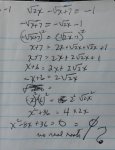allegansveritatem
Full Member
- Joined
- Jan 10, 2018
- Messages
- 962
Here is the equation to be solved for x--it is actually z but I use x in my handwritten working out (attached) to avoid confusion of z with 2:
\(\displaystyle \mbox{41.}\qquad \sqrt{\strut 2z\,}\, -\, \sqrt{\strut z\, +\, 7\,}\, =\, -1\)
Here is what I did--and this is only one version because I turned this every way but loose trying to figure it out:
. . . . .\(\displaystyle \sqrt{\strut 2z\,}\, -\, \sqrt{\strut z\, +\, 7}\, =\, -1\)
. . . . .\(\displaystyle -\sqrt{\strut z\, +\, 7\,}\, =\, -\sqrt{\strut 2z\,}\, -\, 1\)
. . . . .\(\displaystyle \left(-\sqrt{\strut z\, +\, 7\,}\right)^2\, =\, \left(-\sqrt{\strut 2z\,}\, -\, 1\right)^2\)
. . . . .\(\displaystyle z\, +\, 7\, =\, 2z\, +\, \sqrt{\strut 2z\,}\, +\, \sqrt{\strut 2z\,}\, +\, 1\)
. . . . .\(\displaystyle z\, +\, 7\, =\, 2z\, +\, 2\, \sqrt{\strut 2z\,}\, +\, 1\)
. . . . .\(\displaystyle z\, +\, 6\, =\, 2z\, +\, 2\, \sqrt{\strut 2z\,}\)
. . . . .\(\displaystyle -z\, +\, 6\, =\, 2\, \sqrt{\strut2z\,}\)
. . . . .\(\displaystyle (-z)^2\, +\, (6)^2\, =\, (2)^2\, \left(\sqrt{\strut2z\,}\right)^2\)
. . . . .\(\displaystyle z^2\, +\, 36\, =\, 4\, \times\, 2z\)
. . . . .\(\displaystyle z^2\, -\, 8z\, +\, 36\, =\, 0\)
. . . . .no real roots??
I used a calculator to check this and this is what it said: "No real roots."
Here is the book answer: {2}
It must be something fairly simple I am missing here because this is a simple problem. But, apparently I am simpler than it is. What is it?
\(\displaystyle \mbox{41.}\qquad \sqrt{\strut 2z\,}\, -\, \sqrt{\strut z\, +\, 7\,}\, =\, -1\)
Here is what I did--and this is only one version because I turned this every way but loose trying to figure it out:
. . . . .\(\displaystyle \sqrt{\strut 2z\,}\, -\, \sqrt{\strut z\, +\, 7}\, =\, -1\)
. . . . .\(\displaystyle -\sqrt{\strut z\, +\, 7\,}\, =\, -\sqrt{\strut 2z\,}\, -\, 1\)
. . . . .\(\displaystyle \left(-\sqrt{\strut z\, +\, 7\,}\right)^2\, =\, \left(-\sqrt{\strut 2z\,}\, -\, 1\right)^2\)
. . . . .\(\displaystyle z\, +\, 7\, =\, 2z\, +\, \sqrt{\strut 2z\,}\, +\, \sqrt{\strut 2z\,}\, +\, 1\)
. . . . .\(\displaystyle z\, +\, 7\, =\, 2z\, +\, 2\, \sqrt{\strut 2z\,}\, +\, 1\)
. . . . .\(\displaystyle z\, +\, 6\, =\, 2z\, +\, 2\, \sqrt{\strut 2z\,}\)
. . . . .\(\displaystyle -z\, +\, 6\, =\, 2\, \sqrt{\strut2z\,}\)
. . . . .\(\displaystyle (-z)^2\, +\, (6)^2\, =\, (2)^2\, \left(\sqrt{\strut2z\,}\right)^2\)
. . . . .\(\displaystyle z^2\, +\, 36\, =\, 4\, \times\, 2z\)
. . . . .\(\displaystyle z^2\, -\, 8z\, +\, 36\, =\, 0\)
. . . . .no real roots??
I used a calculator to check this and this is what it said: "No real roots."
Here is the book answer: {2}
It must be something fairly simple I am missing here because this is a simple problem. But, apparently I am simpler than it is. What is it?
Attachments
Last edited by a moderator:

